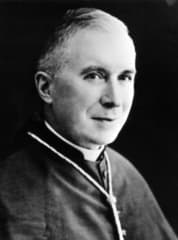アヴェ・マリア!
愛する兄弟姉妹の皆様、
先月は、愛する兄弟姉妹の皆様のしもべの体調が思わしくなくお休みしてしまいましたが、その代わりにクチュール神父様が来日され聖伝のミサを捧げてくださいました。クチュール神父様が御復活後第四主日2011年5月21日の午後に東京でなさってくださった講話を愛する兄弟姉妹の皆様に御紹介します。
天主様の祝福が豊かにありますように!
トマス小野田圭志神父(聖ピオ十世会司祭)
*****
アジア管区長ダニエル・クチュール神父様の講話 第一部
御復活後第四主日2011年5月21日
では祈りましょう。
聖父と聖子と聖霊との御名よりて、アーメン。
聖霊来たり給え、信者の心に満ちたまえ、主の愛熱の火を我らに燃やしめ給え、主よ聖霊を遣わし給え、しかしてよろずのものは創られん、地の面は新たにならん。祈願。聖霊の光を以って信者の心を照らし給いたる天主、同じく聖霊を以って我らに正しき事を悟らしめ、その御慰めによりて常に喜ぶを得しめ給え。我らの主キリストによりて願い奉る。アーメン。
めでたし聖寵満ち満てるマリア、主御身と共にまします。御身は女のうちにて宿せられ、御胎内の御子イエズスも祝せられ給う。天主の御母聖マリア、罪びとなる我らの為に、今も臨終の時も祈り給え。アーメン。
聖ヨゼフ、我らの為に祈り給え。
聖ピオ十世、我らの為に祈り給え。
聖父と聖子と聖霊との御名によりて、アーメン。
本日は元々ファイファー神父様がいらっしゃる予定でした。皆様はきっとファイファー神父様のお話を絶賛するでしょう。と言いますのも、彼は卓越した雄弁家だからです。今度お会いになる時、皆さんはお分かりになるでしょう。ただし今回は私が来ることになりましたので、彼とは違ったお話しを致します。ちなみにあのファイファー神父様は何日間でもお話しの出来る方です。
さて皆さんには是非ともヨハネ・パウロ二世の列福についてお話ししたいと思います。最初に先ず、列聖についての一般的な説明をしてから、聖ピオ十世会がヨハネ・パウロ二世の列福に反対して作成しローマに提出した研究論文についてお話しします。先ずある人が、聖性の誉れの内に亡くなられると、教会はこの方の列聖に至らしめる手続きの開始に当たって非常にゆっくりとしています。列聖とは、ある人が天国にいますという事を、教会が、天主の御名によって、私たちに教える事なのです。第二バチカン公会議までは、通常列聖なるものは不可謬であると教会は教えていました。列福の事ではありません、列聖について言及しています。しかしながら、現在、私たちは教会が行っている列聖の多くに異議を唱えています。何故なら、彼らは列聖の標準規定に従わないからです。要するに彼らは列聖上の規定を変えてしまったのです。
その上彼らは、第二バチカン公会議の列聖を意図して、列聖を行っているところなのです。それこそが、列聖へと導く多くの列福にある本当の目的です。これは伝統的なミサと比較出来ます。伝統的な御ミサは常に有効です。ただし、思いがけず有効でなくなる事もあるのです。
例えば、司祭がワインの変わりにコカコーラを使って御ミサを捧げた場合は無効となってしまうのです。私の知人である司祭に起こった事なのですが、香部屋係りのシスターはワインの変わりにシュワップス(ドイツのお酒)を間違えて準備してしまいました。この司祭は御ミサ中にそれを口にするなりそれがワインでない事に気付きましたが、結局のところ御体の聖変化が起っただけで、御血のそれは起こらなかったのです。ですからイエズス様は(ホスチアの形色の内に)現存しておられましたが、結局御血が欠如していた為に、これはイエズスの(十字架上の)犠牲とはならず、御ミサとして有効をなりませんでした。また列聖に関して言えば、私たちは、教皇様の行為は不可謬であると言わなければならないのですが、それは御自分の行為が不可謬である事を教皇様がお望みの場合、さらに教皇様が列聖上の条件を満たす場合に於いてのみ、この行為は不可謬となります。
ルフェーブル大司教様は、現代の教皇様方は(限定された条件下に於ける)自身の不可謬性を信じておられるかと問うています。そしてその答えは、私たちには分からない、どうやら信じておられないように思える、というものなのです。何故なら、不可謬性とは、教皇が、永遠に真実な何かを今日宣言する事だからです。ですが、近代主義者たちの知性というものは絶えず変わりますし、宣言されたものも今日は真実だが、明日は変更しなければならないかも知れない、と展開するのです。そういう訳で、彼らは自身が真理を未来永劫に定めているとは信じていません。不可謬性は信仰の変革であるところの近代主義に反しているからです。ですから伝統に照らして言いますと、教皇が誰かを列聖する時、この列聖の目的とはカトリック教会の聖性を証明する事なのです。私たちは、異なる国の、異なる年齢の、また異なる条件のメンバーを教会内に持っていることから、至る所に英雄的な徳を見出す事となり、こうして教会は至る所で聖なるものとなります。ですから教皇は「ご覧なさい、聖霊がお働きになっています。聖人があそこに、向うに一人います。」と言うのです。ですから、列聖とは教会の聖性を際立てる事なのです。しかし今、特定の列福と列聖ですが、オプス・デイのエスクリバー師について私たちは思い出しますね。彼の列聖が目的とする所とは、教会の聖性(の強調)というよりはむしろ、第二バチカン公会議の正しさ又は長所(の強調)なのです。これらの方々、思いつくのはオプス・デイのエスクリバー師、それからマザー・テレサ、そしてヨハネニ十三世やヨハネ・パウロ二世ですが、彼らは第二バチカン公会議の教えの模範なのです。模範であるからこそ、彼らは列福又は列聖されたのです。こうなりますと私たちはヨハネ・パウロ世の列福を理解するでしょう。ですがその前に、私はヨハネ・パウロ二世御自身についてお話し致します。それでは簡潔に列聖手続きを見てみましょう。
ここに書き出すものはその要約でありまして、基本的な手続きです。
①先ずは、幾つかの審議手続き、つまり裁判手続きのようなものがあります。その後一定の時間を置いてから、今度は審議の対象となる人の人生を調査する手続きになります。ローマはその人物が住んでいた場所に神学者たちから成るチームを送り、目撃者となる人々に彼或いは彼女を知っているか、あるいはこの人について何か聞いた事があるかをインタビューします。この手続きに於いてこの神学者たちが行う事、つまりその審議項目は、あらゆる徳となりますが、特に対神徳である信仰、希望、愛、それから枢要徳に関する調査です。神学者たち、お望みなら、陪審員団でも良いですが、彼らは一人ずつ如何にこの人が謙遜を実践したか、如何に貞潔を実践したか、如何に信仰、希望、愛を実践したか、という具合に質問します。全ての質問はそこに用意されているのです。そして目撃者たちの方はこの質問に答えなければなりません。仮にこの手続きが上手く行っても、もしこの人物の人生が長かった場合やこの人物が多数の場所で生活した場合、それに応じてこの手続きも非常に長くなります。つまり私たちはこの人物が生活した全ての場所で手続きを行う必要があるのです。
②それから私たちが「悪魔の代弁者」という表現を使うのはここ(手続き②)なのです。この「悪魔の代弁者」とは1人の神学者が務め、この人物の聖性に対してありとあらゆる異議を申し立てます。彼はそこで、ある日この人物は怒ったとか、躓きを与えたなどのあらゆる異議を唱えるのです。その後で、別の神学者がこれらの異議に答えなければなりません。ところでこの「悪魔の代弁者」なる表現はこの列聖審議の手続きから来ています。そしてもしこの人物が首尾よくこのテストを通過しましたら、
③今度はこの人物が持っていた英雄的な徳とその英雄性の度合いに関して宣言がなされます。さらにこの手続きに於いてこの人物は尊者(Venerable)、もしくは天主の召使い(Sevant of God)と呼ばれるのです。それは、これら全ての手続き(①と②)を通過した後に彼らが獲得する最初の称号です。そうしますと私たちには奇跡が必要となります。次の手続き(福者としての宣言)に進むに当たり、天主がハイといわなければならないのです。つまり、その通りです、この人は天国にいますよ、という印ないしは奇跡を私たちに与えなければなりません。それと分かる為にも、天主にしか出来ない何か驚くべき事が起らなければならないのです。伝統的列聖では、この手続きで、(この人物に対する取次ぎの祈りなどによる奇跡の)目撃者に応じて、またどのくらい前の目撃者なのかに応じて、二つあるいは三つ、そうでなければ四つの奇跡が必要でした。もし二百年も前の人物であれば、当然この人物にまつわる奇跡の目撃者など生存しないからです(おそらく奇跡の目撃者が生存した年代が古いだけ、より多くの奇跡が要求される)。また、この人物が福者(Blessed)として宣言される前に、奇跡を幾つ必要とする、というある種の規則が教会にはあります。
しかしこの奇跡を得るには何年も何年も掛かることがあるのです。ですから私たちは短い祈り、例えば(幼きイエズスの)聖テレジアの母、尊者ゼリー・マルタン(Zelie Martin)の列福を求める祈りを唱えるのです:「我が天主よ、御身の奇跡を以ってこの御婦人の聖性を証し給え。」と。だからこそ人々は一斉に奇跡を懇願して祈りに祈るのです。その結果として奇跡が起こるなら、
④列福式(Beatification)が行われまして、例の列福された人物は福者(Blessed)と呼ばれます。この時期に、この福者が生活した場所や限定された司教区、さらに世界中の特定の場所に限り、その公的な崇敬が認められます。彼らは特別な御ミサや祈りを持つ事が出来ますが、それは世界中で使用されるものではありません。
⑤それからこの列福の後に、もう二つの奇跡が必要となります。それは天主がこの人物の崇敬に賛成している事を証明する為です。いったんこの二つの奇跡が科学的に立証され一切の問題がなければ、
⑥ここで列聖式(Canonization)が行われます。こうしてこの人物は聖人(Saint)と呼ばれるのです。ですから、この様に人間的水準に於いては非常に長く、とても難しい手続きでありますし、さらには(尊者宣言後、又は列福宣言前に)この人物が天国にいる事を天主からその奇跡を以って証明してもらう必要があるのです。そして、彼、或いは彼女が天国で御自分と一緒にいるという事の証明として、天主は尊者宣言後の一群の奇跡(2~4つ)と、福者宣言後のもう一群の(二つの)奇跡を起こす事で答えなければならないのです。だからこそ教会から列聖される聖人は僅かしかいないのです。これこそが聖人となる為の伝統的な道のりなのです。
それでは、これまで説明した手続きの中でどれが最難関の手続きだと思いますか?(Aさんが手続き②と答え、Bさんが手続き⑤と答える)はい、もちろん現実には、つまり人間的水準から言えば、この人物の聖徳こそが正に聖性なのですら(列聖審議が公正に行われるだろうと仮定した場合には、「悪魔の代弁者」の異議攻勢を予想すると)最難関の手続きとなります。しかしながら、私たちは審議上のレポートを誤魔化して周囲を欺く事も出来るのです。これは人間の罪深さというものです。ですが、私たちには天主を欺く事、あるいは天主を盲目にする事は出来ません。何故なら、貴方は奇跡に関するレポートの紙を変える事は出来ても、真の奇跡は天主からのみ生じ得るからです(列聖審議が公正に行われないだろうと仮定した場合、誰にも欺く事の出来ない天主からの奇跡を必要とする手続き③と⑤が最難関となる)。
では、第二バチカン公会議に関してなのですが、彼らは奇跡に関する規定を変えてしまいました。現在、手続き③に於いてはたった一つの奇跡が求められるだけであって、次の手続き⑤でも、私やはり一つの奇跡が求められるだけだと思います。ヨハネ・パウロ二世の場合、列福前③の奇跡は一つでした。それは(マリー・シモン・ピエール・ノルマン(Marie Simon Pierre Normand)修道女が患っていた)最も制御の効かない病気であるパーキンソン病の癒しでした。パーキンソン病とは、対処の困難な病気です。それから思い出してください、ヨハネ・パウロ二世が亡くなった時ですが、この彼が死去されたその日である2005年4月2日、バチカン市国の聖ペトロ大聖堂前で、「サント・スビト!サント・スビト!」と記された大きな横断幕を人々は掲げていました。「彼を今すぐ聖人にして下さい!彼を今すぐに聖人に!<つまりこの手続などどうでもいいから>今すぐ彼を列聖してください!彼は聖人です!彼は聖人なのです!」、これこそ、そこにいた人々が叫んでいた事なのです。しかし、かつての教会法では、私たちは列聖候補となった人物の聖徳を審議するこの手続き①と②に至るまで、20年か30年、あるいは40年は待たなければなりませんでした。というのも、たくさんの情動(emotions)があるからです。
ですから教会はこの情動に対して非常に慎重でした。「この情動が消え去るまで待ちましょう。今は天主がこの情動(this)の正否を示して下さるまで待ちましょう」と教会は言ったのです。ヨハネ・パウロ二世の場合、列福審議の手続きは彼の死後1ヶ月して開始されました。ポーランドは長年共産主義に支配されましたね。ヨハネ・パウロ二世は2005年4月2日に亡くなりました。カロル・ヴォイティワ(将来のヨハネ・パウロ二世)、つまりポーランドに於けるヨハネ・パウロ二世に関する列福審議の手続きは、(共産国)ポーランドの秘密公文書保管所にアクセスしておらず、その内容は2007年になってからようやく公表されたのです。
ですから、一連の列福審議手続きの内、最初のものだった(クラクフ)司教区に於ける審議手続きは、彼らがこの秘密公文書保管所にアクセスする前に終了しています。当司教区の方々がヨハネ・パウロ二世を列福する予定だと聞くやいなや、フェレー司教様はある文書を用意され、私たちはそれを列福審議手続きの為にとポーランドに送りました。しかも、送られて来た封筒、つまり(彼に関する)証言や異議などを収集する為の時間がありましたので、それを記録した文書を同封した封筒を彼らが間に合って受け取った事を私たちは知っています。しかし彼らはそれを開きもせず、ようやく開いてくれた時には、例の司教区の審議手続き期間は終了していました。すると今度は、彼に関する審議手続きがローマに移りましたので、私たちはこれと同じ文書をローマにも送りました。27年間、彼は教皇でした。彼は130ヶ国以上に歴訪したのです。彼はおよそ一万回以上に亘って謁見を行いました。それは膨大な量の活動ですよ!この段階で、私たちはあらゆる事柄を調査しなければならないのです。
要するに、私たちからの異議の全てを合わせて、あの文書をこの(ホワイトボードを指して)列福審議手続き①の為に、最初はポーランド、それからローマに送ったという訳です。しかしローマでさえこの文書の検討を拒絶してしまいました。私たちがローマと討論して来た事を皆さんは御存知ですね。しかしそれはもう終わってしまいました。ローマと二年間に亘り討論して来たのです。ある日ローマとの討論の一つの中で、私たちは「皆様はヨハネ・パウロ二世の列福をお望みですが、この列福に対する私たちの異議がここにご在います」と言ってローマ委員会に例の文書をお渡ししました。この出来事は、ちょうどこの部分(ホワイトボードに書かれた手続き③を指す)、ちょうど聖徳に関する(福者)宣言がされた後であり、奇跡を求める前の段階だったと思います。そうしますと不思議な事に、突如として全てが数ヶ月間ストップしてしまったのです。ところが、それから間もなくして一つの奇跡が起こりましたので、彼らは今月の1日になって彼を列福したのです。
これに関して何かご質問ありますか?(「天主が与える奇跡に間違いはないと言われますが、ヨハネ・パウロ二世の列福前に(手続き③で)与えられた一つの奇跡についてはどう解釈すべきですか?」とAさんが質問する。)
私は個人的にこの奇跡の研究をしていませんが、今回フランス人修道女に起きた奇跡については議論が交わされています。他の聖人たちを見ますと、例えば聖ピオ十世ですが、彼の列福と列聖に先駆けて起きた奇跡は明白なものです。疑う余地のない、つまり絶対に疑い得ないものなのです。しかしこの(ヨハネ・パウロ二世の列福前に起きた)奇跡はすっきりとしないものですし、明瞭ではありません。それから本来必要とされる二つか三つ、或いは四つの奇跡の代わりとして、一つの奇跡しかないという事実があります。ですからあの奇跡はヨハネ・パウロ二世の為に与えられたのかどうかという疑いが存在しています。カリスマ運動やプロテスタントの神霊治療家(いわゆるヒーラー)、あるいはカトリックのそれについて再度考えてみて下さい。彼らは何千もの奇跡を行うと主張しますが、教会はそれを奇跡として認めません。ここ(③)に於ける奇跡では、この人間が本当に病気であった事が証明されなければならないのです。つまり医学的証拠というものです。それがなされれば奇跡となります。ただしそれ以外にも、この癒しが真正なものかを確かめる為の時間が不可欠となります。場合によっては、癒しが真正のものであると装う人もいるでしょうし、この奇跡を巡る虚偽もあり得るからです。ルルドであれば、彼らは癒された人に対して6ヶ月後に再び戻って来て、依然として癒し後の体調に変化はないか診断書の提出を要求するでしょう。
しかしヨハネ・パウロ二世に関する審議の場合、彼らは非常に早く事を進めたかったので、多くの審議項目を省いています。このやり方は危険でありますし、以前ほどの明瞭がありません。
(Cさんが「ヨハネニ十三世の列福に関してはどう考えるべきですか?」と質問する。)
多くの類似点があります。個人的に調べていませんが、最初から同じ手続き手法を適用していて、奇跡は一つしかなかったにも拘らず、彼らはこの教皇様を列福してしまいました。その理由とは、彼ヨハネニ十三世こそが第二バチカン公会議を招集し、それを開催したからと言うものでした。つまり、この列福の論点は、当の本人(の聖性云々)よりも、むしろ第二バチカン公会議(の長所)にあるのです。だからこそ私たちはこれに同意しないのです。
(Bさんがここである質問をするが、かなりショッキングなので割愛する。)
セデ・ヴァカンティストたちでさえそれについて言及するのを私は聞いた事がありません。ただ何れにせよ、そういう事もありますので、異議を申し立てる手続きが重要となります。そして私たちは投げ掛けられた一つ一つの異議を分析しなければならないのです。
愛する兄弟姉妹の皆様、
先月は、愛する兄弟姉妹の皆様のしもべの体調が思わしくなくお休みしてしまいましたが、その代わりにクチュール神父様が来日され聖伝のミサを捧げてくださいました。クチュール神父様が御復活後第四主日2011年5月21日の午後に東京でなさってくださった講話を愛する兄弟姉妹の皆様に御紹介します。
天主様の祝福が豊かにありますように!
トマス小野田圭志神父(聖ピオ十世会司祭)
アジア管区長ダニエル・クチュール神父様の講話 第一部
御復活後第四主日2011年5月21日
では祈りましょう。
聖父と聖子と聖霊との御名よりて、アーメン。
聖霊来たり給え、信者の心に満ちたまえ、主の愛熱の火を我らに燃やしめ給え、主よ聖霊を遣わし給え、しかしてよろずのものは創られん、地の面は新たにならん。祈願。聖霊の光を以って信者の心を照らし給いたる天主、同じく聖霊を以って我らに正しき事を悟らしめ、その御慰めによりて常に喜ぶを得しめ給え。我らの主キリストによりて願い奉る。アーメン。
めでたし聖寵満ち満てるマリア、主御身と共にまします。御身は女のうちにて宿せられ、御胎内の御子イエズスも祝せられ給う。天主の御母聖マリア、罪びとなる我らの為に、今も臨終の時も祈り給え。アーメン。
聖ヨゼフ、我らの為に祈り給え。
聖ピオ十世、我らの為に祈り給え。
聖父と聖子と聖霊との御名によりて、アーメン。
本日は元々ファイファー神父様がいらっしゃる予定でした。皆様はきっとファイファー神父様のお話を絶賛するでしょう。と言いますのも、彼は卓越した雄弁家だからです。今度お会いになる時、皆さんはお分かりになるでしょう。ただし今回は私が来ることになりましたので、彼とは違ったお話しを致します。ちなみにあのファイファー神父様は何日間でもお話しの出来る方です。
さて皆さんには是非ともヨハネ・パウロ二世の列福についてお話ししたいと思います。最初に先ず、列聖についての一般的な説明をしてから、聖ピオ十世会がヨハネ・パウロ二世の列福に反対して作成しローマに提出した研究論文についてお話しします。先ずある人が、聖性の誉れの内に亡くなられると、教会はこの方の列聖に至らしめる手続きの開始に当たって非常にゆっくりとしています。列聖とは、ある人が天国にいますという事を、教会が、天主の御名によって、私たちに教える事なのです。第二バチカン公会議までは、通常列聖なるものは不可謬であると教会は教えていました。列福の事ではありません、列聖について言及しています。しかしながら、現在、私たちは教会が行っている列聖の多くに異議を唱えています。何故なら、彼らは列聖の標準規定に従わないからです。要するに彼らは列聖上の規定を変えてしまったのです。
その上彼らは、第二バチカン公会議の列聖を意図して、列聖を行っているところなのです。それこそが、列聖へと導く多くの列福にある本当の目的です。これは伝統的なミサと比較出来ます。伝統的な御ミサは常に有効です。ただし、思いがけず有効でなくなる事もあるのです。
例えば、司祭がワインの変わりにコカコーラを使って御ミサを捧げた場合は無効となってしまうのです。私の知人である司祭に起こった事なのですが、香部屋係りのシスターはワインの変わりにシュワップス(ドイツのお酒)を間違えて準備してしまいました。この司祭は御ミサ中にそれを口にするなりそれがワインでない事に気付きましたが、結局のところ御体の聖変化が起っただけで、御血のそれは起こらなかったのです。ですからイエズス様は(ホスチアの形色の内に)現存しておられましたが、結局御血が欠如していた為に、これはイエズスの(十字架上の)犠牲とはならず、御ミサとして有効をなりませんでした。また列聖に関して言えば、私たちは、教皇様の行為は不可謬であると言わなければならないのですが、それは御自分の行為が不可謬である事を教皇様がお望みの場合、さらに教皇様が列聖上の条件を満たす場合に於いてのみ、この行為は不可謬となります。
ルフェーブル大司教様は、現代の教皇様方は(限定された条件下に於ける)自身の不可謬性を信じておられるかと問うています。そしてその答えは、私たちには分からない、どうやら信じておられないように思える、というものなのです。何故なら、不可謬性とは、教皇が、永遠に真実な何かを今日宣言する事だからです。ですが、近代主義者たちの知性というものは絶えず変わりますし、宣言されたものも今日は真実だが、明日は変更しなければならないかも知れない、と展開するのです。そういう訳で、彼らは自身が真理を未来永劫に定めているとは信じていません。不可謬性は信仰の変革であるところの近代主義に反しているからです。ですから伝統に照らして言いますと、教皇が誰かを列聖する時、この列聖の目的とはカトリック教会の聖性を証明する事なのです。私たちは、異なる国の、異なる年齢の、また異なる条件のメンバーを教会内に持っていることから、至る所に英雄的な徳を見出す事となり、こうして教会は至る所で聖なるものとなります。ですから教皇は「ご覧なさい、聖霊がお働きになっています。聖人があそこに、向うに一人います。」と言うのです。ですから、列聖とは教会の聖性を際立てる事なのです。しかし今、特定の列福と列聖ですが、オプス・デイのエスクリバー師について私たちは思い出しますね。彼の列聖が目的とする所とは、教会の聖性(の強調)というよりはむしろ、第二バチカン公会議の正しさ又は長所(の強調)なのです。これらの方々、思いつくのはオプス・デイのエスクリバー師、それからマザー・テレサ、そしてヨハネニ十三世やヨハネ・パウロ二世ですが、彼らは第二バチカン公会議の教えの模範なのです。模範であるからこそ、彼らは列福又は列聖されたのです。こうなりますと私たちはヨハネ・パウロ世の列福を理解するでしょう。ですがその前に、私はヨハネ・パウロ二世御自身についてお話し致します。それでは簡潔に列聖手続きを見てみましょう。
ここに書き出すものはその要約でありまして、基本的な手続きです。
①先ずは、幾つかの審議手続き、つまり裁判手続きのようなものがあります。その後一定の時間を置いてから、今度は審議の対象となる人の人生を調査する手続きになります。ローマはその人物が住んでいた場所に神学者たちから成るチームを送り、目撃者となる人々に彼或いは彼女を知っているか、あるいはこの人について何か聞いた事があるかをインタビューします。この手続きに於いてこの神学者たちが行う事、つまりその審議項目は、あらゆる徳となりますが、特に対神徳である信仰、希望、愛、それから枢要徳に関する調査です。神学者たち、お望みなら、陪審員団でも良いですが、彼らは一人ずつ如何にこの人が謙遜を実践したか、如何に貞潔を実践したか、如何に信仰、希望、愛を実践したか、という具合に質問します。全ての質問はそこに用意されているのです。そして目撃者たちの方はこの質問に答えなければなりません。仮にこの手続きが上手く行っても、もしこの人物の人生が長かった場合やこの人物が多数の場所で生活した場合、それに応じてこの手続きも非常に長くなります。つまり私たちはこの人物が生活した全ての場所で手続きを行う必要があるのです。
②それから私たちが「悪魔の代弁者」という表現を使うのはここ(手続き②)なのです。この「悪魔の代弁者」とは1人の神学者が務め、この人物の聖性に対してありとあらゆる異議を申し立てます。彼はそこで、ある日この人物は怒ったとか、躓きを与えたなどのあらゆる異議を唱えるのです。その後で、別の神学者がこれらの異議に答えなければなりません。ところでこの「悪魔の代弁者」なる表現はこの列聖審議の手続きから来ています。そしてもしこの人物が首尾よくこのテストを通過しましたら、
③今度はこの人物が持っていた英雄的な徳とその英雄性の度合いに関して宣言がなされます。さらにこの手続きに於いてこの人物は尊者(Venerable)、もしくは天主の召使い(Sevant of God)と呼ばれるのです。それは、これら全ての手続き(①と②)を通過した後に彼らが獲得する最初の称号です。そうしますと私たちには奇跡が必要となります。次の手続き(福者としての宣言)に進むに当たり、天主がハイといわなければならないのです。つまり、その通りです、この人は天国にいますよ、という印ないしは奇跡を私たちに与えなければなりません。それと分かる為にも、天主にしか出来ない何か驚くべき事が起らなければならないのです。伝統的列聖では、この手続きで、(この人物に対する取次ぎの祈りなどによる奇跡の)目撃者に応じて、またどのくらい前の目撃者なのかに応じて、二つあるいは三つ、そうでなければ四つの奇跡が必要でした。もし二百年も前の人物であれば、当然この人物にまつわる奇跡の目撃者など生存しないからです(おそらく奇跡の目撃者が生存した年代が古いだけ、より多くの奇跡が要求される)。また、この人物が福者(Blessed)として宣言される前に、奇跡を幾つ必要とする、というある種の規則が教会にはあります。
しかしこの奇跡を得るには何年も何年も掛かることがあるのです。ですから私たちは短い祈り、例えば(幼きイエズスの)聖テレジアの母、尊者ゼリー・マルタン(Zelie Martin)の列福を求める祈りを唱えるのです:「我が天主よ、御身の奇跡を以ってこの御婦人の聖性を証し給え。」と。だからこそ人々は一斉に奇跡を懇願して祈りに祈るのです。その結果として奇跡が起こるなら、
④列福式(Beatification)が行われまして、例の列福された人物は福者(Blessed)と呼ばれます。この時期に、この福者が生活した場所や限定された司教区、さらに世界中の特定の場所に限り、その公的な崇敬が認められます。彼らは特別な御ミサや祈りを持つ事が出来ますが、それは世界中で使用されるものではありません。
⑤それからこの列福の後に、もう二つの奇跡が必要となります。それは天主がこの人物の崇敬に賛成している事を証明する為です。いったんこの二つの奇跡が科学的に立証され一切の問題がなければ、
⑥ここで列聖式(Canonization)が行われます。こうしてこの人物は聖人(Saint)と呼ばれるのです。ですから、この様に人間的水準に於いては非常に長く、とても難しい手続きでありますし、さらには(尊者宣言後、又は列福宣言前に)この人物が天国にいる事を天主からその奇跡を以って証明してもらう必要があるのです。そして、彼、或いは彼女が天国で御自分と一緒にいるという事の証明として、天主は尊者宣言後の一群の奇跡(2~4つ)と、福者宣言後のもう一群の(二つの)奇跡を起こす事で答えなければならないのです。だからこそ教会から列聖される聖人は僅かしかいないのです。これこそが聖人となる為の伝統的な道のりなのです。
それでは、これまで説明した手続きの中でどれが最難関の手続きだと思いますか?(Aさんが手続き②と答え、Bさんが手続き⑤と答える)はい、もちろん現実には、つまり人間的水準から言えば、この人物の聖徳こそが正に聖性なのですら(列聖審議が公正に行われるだろうと仮定した場合には、「悪魔の代弁者」の異議攻勢を予想すると)最難関の手続きとなります。しかしながら、私たちは審議上のレポートを誤魔化して周囲を欺く事も出来るのです。これは人間の罪深さというものです。ですが、私たちには天主を欺く事、あるいは天主を盲目にする事は出来ません。何故なら、貴方は奇跡に関するレポートの紙を変える事は出来ても、真の奇跡は天主からのみ生じ得るからです(列聖審議が公正に行われないだろうと仮定した場合、誰にも欺く事の出来ない天主からの奇跡を必要とする手続き③と⑤が最難関となる)。
では、第二バチカン公会議に関してなのですが、彼らは奇跡に関する規定を変えてしまいました。現在、手続き③に於いてはたった一つの奇跡が求められるだけであって、次の手続き⑤でも、私やはり一つの奇跡が求められるだけだと思います。ヨハネ・パウロ二世の場合、列福前③の奇跡は一つでした。それは(マリー・シモン・ピエール・ノルマン(Marie Simon Pierre Normand)修道女が患っていた)最も制御の効かない病気であるパーキンソン病の癒しでした。パーキンソン病とは、対処の困難な病気です。それから思い出してください、ヨハネ・パウロ二世が亡くなった時ですが、この彼が死去されたその日である2005年4月2日、バチカン市国の聖ペトロ大聖堂前で、「サント・スビト!サント・スビト!」と記された大きな横断幕を人々は掲げていました。「彼を今すぐ聖人にして下さい!彼を今すぐに聖人に!<つまりこの手続などどうでもいいから>今すぐ彼を列聖してください!彼は聖人です!彼は聖人なのです!」、これこそ、そこにいた人々が叫んでいた事なのです。しかし、かつての教会法では、私たちは列聖候補となった人物の聖徳を審議するこの手続き①と②に至るまで、20年か30年、あるいは40年は待たなければなりませんでした。というのも、たくさんの情動(emotions)があるからです。
ですから教会はこの情動に対して非常に慎重でした。「この情動が消え去るまで待ちましょう。今は天主がこの情動(this)の正否を示して下さるまで待ちましょう」と教会は言ったのです。ヨハネ・パウロ二世の場合、列福審議の手続きは彼の死後1ヶ月して開始されました。ポーランドは長年共産主義に支配されましたね。ヨハネ・パウロ二世は2005年4月2日に亡くなりました。カロル・ヴォイティワ(将来のヨハネ・パウロ二世)、つまりポーランドに於けるヨハネ・パウロ二世に関する列福審議の手続きは、(共産国)ポーランドの秘密公文書保管所にアクセスしておらず、その内容は2007年になってからようやく公表されたのです。
ですから、一連の列福審議手続きの内、最初のものだった(クラクフ)司教区に於ける審議手続きは、彼らがこの秘密公文書保管所にアクセスする前に終了しています。当司教区の方々がヨハネ・パウロ二世を列福する予定だと聞くやいなや、フェレー司教様はある文書を用意され、私たちはそれを列福審議手続きの為にとポーランドに送りました。しかも、送られて来た封筒、つまり(彼に関する)証言や異議などを収集する為の時間がありましたので、それを記録した文書を同封した封筒を彼らが間に合って受け取った事を私たちは知っています。しかし彼らはそれを開きもせず、ようやく開いてくれた時には、例の司教区の審議手続き期間は終了していました。すると今度は、彼に関する審議手続きがローマに移りましたので、私たちはこれと同じ文書をローマにも送りました。27年間、彼は教皇でした。彼は130ヶ国以上に歴訪したのです。彼はおよそ一万回以上に亘って謁見を行いました。それは膨大な量の活動ですよ!この段階で、私たちはあらゆる事柄を調査しなければならないのです。
要するに、私たちからの異議の全てを合わせて、あの文書をこの(ホワイトボードを指して)列福審議手続き①の為に、最初はポーランド、それからローマに送ったという訳です。しかしローマでさえこの文書の検討を拒絶してしまいました。私たちがローマと討論して来た事を皆さんは御存知ですね。しかしそれはもう終わってしまいました。ローマと二年間に亘り討論して来たのです。ある日ローマとの討論の一つの中で、私たちは「皆様はヨハネ・パウロ二世の列福をお望みですが、この列福に対する私たちの異議がここにご在います」と言ってローマ委員会に例の文書をお渡ししました。この出来事は、ちょうどこの部分(ホワイトボードに書かれた手続き③を指す)、ちょうど聖徳に関する(福者)宣言がされた後であり、奇跡を求める前の段階だったと思います。そうしますと不思議な事に、突如として全てが数ヶ月間ストップしてしまったのです。ところが、それから間もなくして一つの奇跡が起こりましたので、彼らは今月の1日になって彼を列福したのです。
これに関して何かご質問ありますか?(「天主が与える奇跡に間違いはないと言われますが、ヨハネ・パウロ二世の列福前に(手続き③で)与えられた一つの奇跡についてはどう解釈すべきですか?」とAさんが質問する。)
私は個人的にこの奇跡の研究をしていませんが、今回フランス人修道女に起きた奇跡については議論が交わされています。他の聖人たちを見ますと、例えば聖ピオ十世ですが、彼の列福と列聖に先駆けて起きた奇跡は明白なものです。疑う余地のない、つまり絶対に疑い得ないものなのです。しかしこの(ヨハネ・パウロ二世の列福前に起きた)奇跡はすっきりとしないものですし、明瞭ではありません。それから本来必要とされる二つか三つ、或いは四つの奇跡の代わりとして、一つの奇跡しかないという事実があります。ですからあの奇跡はヨハネ・パウロ二世の為に与えられたのかどうかという疑いが存在しています。カリスマ運動やプロテスタントの神霊治療家(いわゆるヒーラー)、あるいはカトリックのそれについて再度考えてみて下さい。彼らは何千もの奇跡を行うと主張しますが、教会はそれを奇跡として認めません。ここ(③)に於ける奇跡では、この人間が本当に病気であった事が証明されなければならないのです。つまり医学的証拠というものです。それがなされれば奇跡となります。ただしそれ以外にも、この癒しが真正なものかを確かめる為の時間が不可欠となります。場合によっては、癒しが真正のものであると装う人もいるでしょうし、この奇跡を巡る虚偽もあり得るからです。ルルドであれば、彼らは癒された人に対して6ヶ月後に再び戻って来て、依然として癒し後の体調に変化はないか診断書の提出を要求するでしょう。
しかしヨハネ・パウロ二世に関する審議の場合、彼らは非常に早く事を進めたかったので、多くの審議項目を省いています。このやり方は危険でありますし、以前ほどの明瞭がありません。
(Cさんが「ヨハネニ十三世の列福に関してはどう考えるべきですか?」と質問する。)
多くの類似点があります。個人的に調べていませんが、最初から同じ手続き手法を適用していて、奇跡は一つしかなかったにも拘らず、彼らはこの教皇様を列福してしまいました。その理由とは、彼ヨハネニ十三世こそが第二バチカン公会議を招集し、それを開催したからと言うものでした。つまり、この列福の論点は、当の本人(の聖性云々)よりも、むしろ第二バチカン公会議(の長所)にあるのです。だからこそ私たちはこれに同意しないのです。
(Bさんがここである質問をするが、かなりショッキングなので割愛する。)
セデ・ヴァカンティストたちでさえそれについて言及するのを私は聞いた事がありません。ただ何れにせよ、そういう事もありますので、異議を申し立てる手続きが重要となります。そして私たちは投げ掛けられた一つ一つの異議を分析しなければならないのです。












































